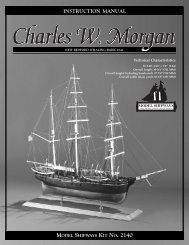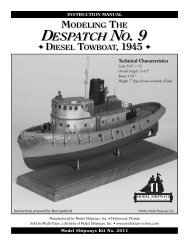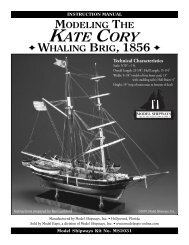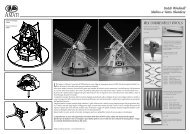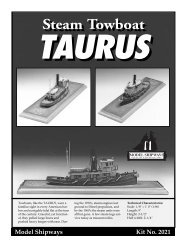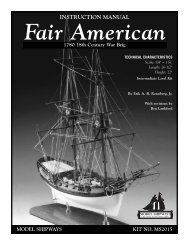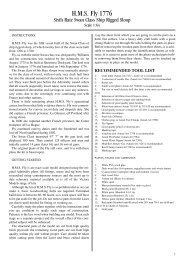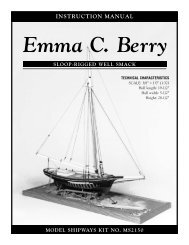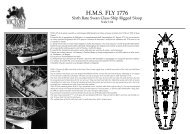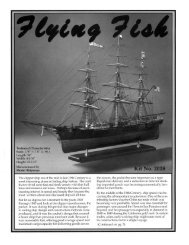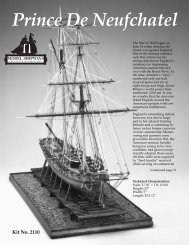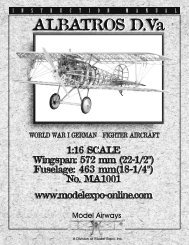download benjamin latham instruction manual
download benjamin latham instruction manual
download benjamin latham instruction manual
Create successful ePaper yourself
Turn your PDF publications into a flip-book with our unique Google optimized e-Paper software.
The top of the sternpost requires a slight recess where the rudder<br />
stock will be located. Carve this in before installing the<br />
sternpost (also see figure 3).<br />
Option: You can add the keel-stem and sternpost before cutting<br />
the rabbet. It makes the rabbet a little more difficult to cut,<br />
but allows an easier installation of the keel-stem because there<br />
is more gluing surface.<br />
FIG. 5 – Fore & Aft Bevel of Stanchions<br />
3/16”bulkhead<br />
1/8”<br />
Sanding<br />
block<br />
4. Installing the Bulkheads<br />
The bulkheads are labeled “A” through “N”. Compare the<br />
laser-cut bulkheads with the plans to determine which is<br />
which and label each bulkhead. Check each bulkhead to make<br />
sure it will slide into the center keel slots. Machine tolerances<br />
during laser cutting may provide a too tight fit. Sand the slots,<br />
if necessary, until the bulkheads slip on. The fit should be<br />
snug, allowing a little tolerance for glue.<br />
On each bulkhead, mark the location of the WL-6 reference line<br />
in pencil. This mark should line up with the WL-6 mark on the<br />
center keel. This alignment will assure that the hull form is accurate<br />
and that each bulkhead is in correct relationship to the<br />
others.<br />
Next, mark the bevels on the bulkheads. Use a tick strip to<br />
transfer the bevel line as shown on the plans, or cut the bulkhead<br />
patterns from the plan and glue them onto the bulkheads.<br />
You may also lay the pattern over the bulkhead and use a pin<br />
prick to locate the bevel. Cut the bevels with a #11 hobby knife<br />
blade (see figure 4).<br />
Some of the bevels are very slight, especially the deck bevels<br />
and the side bevels near amidships. These can be sanded after<br />
the bulkheads are installed, instead of pre-cutting them.<br />
5/32”<br />
FIG. 6 – Installing the Bulkheads<br />
WL-6 must<br />
line up<br />
Tack temporary strip<br />
until glue dries<br />
All of the laser-cut bulkheads extend up to the underside of the<br />
main rail to include a timberhead (bulwark stanchion). Consequently,<br />
bevels must be cut on the inside of the stanchions as<br />
well as on the outside. The bulkheads are located at every third<br />
stanchion. Two additional “fake” stanchions will be added between<br />
the bulkheads after the hull is planked.<br />
In addition to the side bevels, the bulwark stanchion portion of<br />
each bulkhead must be shaped on the fore and aft side. This<br />
can be done with a sanding block (see figure 5). The stanchions<br />
taper slightly and are about 1/8” wide at the rail and 5/32” at<br />
the deck.<br />
Glue the bulkheads in place, making sure that the WL-6 marks<br />
on the bulkheads and the center keel line up. Use a square to<br />
make each bulkhead perpendicular to the center keel. Then<br />
tack a temporary strip to the top of each bulkhead to hold it in<br />
place while the glue dries (see figure 6).<br />
After all bulkheads are in place, tack a temporary batten on<br />
each side of the hull just below the deck (see figure 7). This is a<br />
critical step. Measure the spacing between bulkheads and retack<br />
the battens until the hull is aligned. Even though the center<br />
keel was assembled flat, it could warp out of line. The end<br />
result would be a banana-shaped hull. Check the spacings between<br />
bulkheads, and port against starboard spacings. Check<br />
the hull visually to see if it is properly aligned.<br />
When you are satisfied that the hull is aligned, make sure the<br />
bottom of each bulkhead feathers out and lays precisely on the<br />
bearding line. Trim as necessary to line up. Also, check to see<br />
that the top of each bulkhead at the centerline is flush or slightly<br />
higher than the center keel. Since all alignment is based on<br />
the WL-6 marks, there could be some slight errors. If the center<br />
keel is below the top of the bulkheads, that’s OK. If above, trim<br />
the center keel until it is flush with the bulkheads.<br />
Glue Check 90°<br />
with square<br />
FIG. 7 – Aligning the Bulkheads, using Battens<br />
Check alignment<br />
visually in all directions<br />
Check spacing<br />
Check straightness<br />
of center keel with<br />
straight edge<br />
Tack temporary<br />
batten on hull<br />
11



